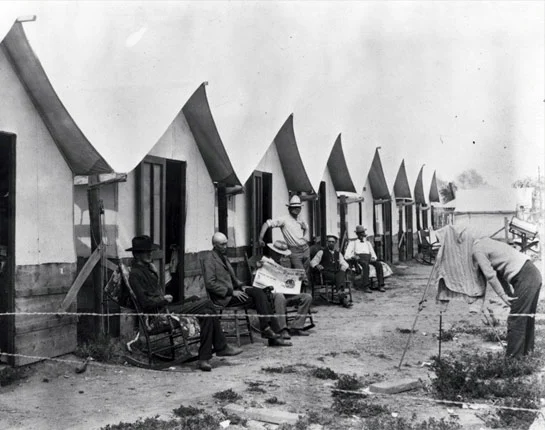San Antonio Insane Asylum

The San Antonio Insane Asylum was a place of horror. It was where the unwanted and the misunderstood were locked away, never to see the light of day again. The patients who were sent here were often deemed insane by society.
Still, many were misunderstood or suffering from mental illnesses that could have been appropriately treated. Instead, they were subjected to inhumane treatment and left to rot in their filth and madness.
The San Antonio Insane Asylum was notorious for its inhumane practices. Patients were often physically restrained, beaten, and abused by the staff. They were subjected to experimental treatments that bordered on torture, such as electroshock therapy and lobotomies.
The conditions within the asylum were deplorable, with patients crammed into overcrowded cells with no access to basic amenities like sanitation, food, or water. The inmates were forced to live in squalor and filth, often left to wallow in their excrement for days.
Many patients sent to the San Antonio Insane Asylum were not even mentally ill. They were unwanted by society and deemed a burden on their families or community. They were locked away in the asylum, forgotten and abandoned by their loved ones.
Many patients died within the asylum walls, and their suffering and anguish were never acknowledged or addressed.
It is a tragedy that the San Antonio Insane Asylum was allowed to exist for so long, perpetuating cruelty and neglect toward those who needed help the most.
It is a reminder of the dark side of humanity, where those who are different or misunderstood are cast aside and forgotten. We must learn from past mistakes and ensure that no one suffers such cruel and inhumane treatment ever again.
The San Antonio Insane Asylum Was a Place Of Horrific Crimes

The people who were sent to these asylums were often subjected to gruesome brutality and inhumane treatment. And the filthy wooden bed they were forced to lie on only added to their misery.
The bed, or rather the wooden plank with no cushioning or support, was a symbol of the horrors that these patients endured. The bed was never cleaned properly, and the patients were left lying on it for days, sometimes even weeks, without any change of sheets or even a simple washcloth. The stench of urine and feces filled the air, and disease and infection were rampant.
The patients who were deemed “insane” were already stripped of their basic human rights, and the filthy wooden bed was just another way to dehumanize them further. It was a tool used to break their spirits and crush any remaining hope they had left.
The fact that such brutality was allowed to happen in the name of “psychiatric treatment” is a shameful stain on our history. The filthy wooden bed serves as a reminder of the atrocities committed in insane asylums and the need for compassion and understanding when treating mental illness.
The San Antonio Insane Asylum was a place of hopelessness. Patients admitted there were treated as outcasts, stripped of their dignity and humanity. The mere thought of what went on inside those walls makes even the bravest souls tremble. The asylum was a place where people went to die, both physically and mentally.
Today, the San Antonio Insane Asylum is a stark reminder of the mistakes we made in the past. It is a cautionary tale for future generations never to forget the atrocities that once plagued our society.
We must remember the lessons of our past to build a better future, one where mental health is treated with compassion and understanding. But we can never forget the darkness that once lurked within the walls of the San Antonio Insane Asylum.
There Were Many Troubles At The Insane Asylum
The property that housed the Juvenile Home & Training School was a unique institution. For one, it included the school, the Superintendent’s quarters, and the Tubercular Colony, which was nothing more than a few tents. Such an assortment of structures only added to the eerie atmosphere that pervaded the place. But what made it notorious were the immoral activities within its walls, leading to death and destruction.
One such incident occurred in 1934 when a 12-year-old boy, who had been sent to the school because of his drug addiction, managed to escape his confines. Unfortunately, his newfound freedom did not last long, as he was soon re-arrested on a murder charge. The victim? An 11-year-old girl. Such horrors were daily in this place, where troubled youths were sent to be “rehabilitated.” Some may argue that these immoral activities and environments led to such tragic outcomes.
It wasn’t just the students who were at risk either. In 1939, three top officials, including Superintendent Roger Cook, were fired for their nefarious activities. Rumor has it that they threw wild parties within the school’s walls and even brought women into the premises. The brazen disregard for discipline and propriety only added to the already bleak atmosphere of the place. It’s no wonder that bad activities led to death and destruction in this institution that was supposed to be a haven for troubled youths.
The Juvenile Home & Training School may have been shut down long ago, but its legacy lives on in the memories of those once confined within its walls. The property may now be abandoned and derelict, but one can’t help but wonder if the ghosts of those who suffered within its walls still linger, haunting where they met their untimely demise. It is a stark reminder of how bad activities can lead to tragic outcomes, especially when they involve impressionable young minds.
The Tubercular Colony

The San Antonio Insane Asylum is a place shrouded in mystery and horror. The Tubercular Colony patients who lived here suffered a fate worse than death.
These patients were left to die, alone and forgotten, in this desolate place. They were forced to live in tents until they succumbed to the deadly disease – tuberculosis. Their meals were taken to those who could not reach the Home of the Aged, which offered little comfort in the face of such a cruel disease.

Southwestern Insane Asylum Is Another San Antonio Insane Asylum

The dark history of the South West Insane Asylum, also known as San Antonio State Hospital. In the early 1900s, the hospital was home to hundreds of patients who suffered from various mental illnesses. It was hard to imagine the horror at the South West Insane Asylum all those years ago.
The mere mention of an insane asylum sends shivers down my spine. From movies to books, we have all heard stories of the inhumane treatment of patients in such institutions. The San Antonio State Hospital, formerly the Southwestern Insane Asylum, is no exception.
Its history is a haunting tale of horror and tragedy. It is believed that the cruel treatment of inmates in these places is the cause of these paranormal happenings, and San Antonio State Hospital is no different.
The patients in the Southwestern Insane Asylum were subjected to unimaginable cruelty and neglect. The staff was untrained and overworked, and the patients were left to fend for themselves.
As a result, many patients suffered from malnutrition, disease, and even death. The asylum was also known for its brutal treatment methods, including electroshock therapy, lobotomies, and other experimental procedures.


South Western Insane Asylum is Haunted Today
Unsurprisingly, many believe that the suffering of the patients has led to paranormal activity in the San Antonio State Hospital. Visitors have reported hearing voices, seeing apparitions, and feeling an eerie presence throughout the building. Some have even claimed to have been touched or pushed by unseen forces.
The San Antonio State Hospital’s history is dark and tragic. It serves as a reminder of the inhumane treatment of mentally ill patients. The paranormal activity within its walls is a testament to these patients’ suffering.
It’s a chilling thought to imagine the spirits of these tormented individuals still lingering in the hospital halls. One thing is for sure; a visit to San Antonio State Hospital is not for the faint-hearted.
The San Antonio State Hospital’s history is dark and tragic. It serves as a reminder of the inhumane treatment of mentally ill patients. The paranormal activity within its walls is a testament to these patients’ suffering.
The majority of the employees at the hospital seem to be aware of the supernatural occurrences, but they are not willing to take any action. One former employee indicated it would be unusual if no ghostly legends were tied to the premises.
A current hospital worker has been there for eight years and has described it as a “scary place.” Another individual employed there said, “We can sense the presence of death… We are aware of the occurrences happening around us.”
The past of the San Antonio State Hospital, once the Southwestern Insane Asylum, is particularly hard to understand. It is a history of suffering, dishonesty, and mortality.
The Lunacy Act of 1845

The Lunacy Act of 1845 determined that all asylums were obligated to keep an admission book which was an archive of the present, including demographic information, diagnosis details, the disorder’s source, and the age of the first attack.
This book would also contain information regarding the time of discharge or death and the patient’s recovery state. Using the admission book from 1870–1875 (County Record Office, Truro), data were collected on demographics and illnesses as well as the results of the treatments.
The majority of patients were labeled as having mania (38%), dementia (35%), or melancholia (26%).
